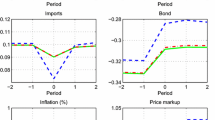Abstract
This paper overviews the joint strategy of the Bank of Slovenia and of the Government of Slovenian for the policy management in the Exchange Rate Mechanism II (ERM II) and the eventual adoption of the euro. The current prospects of the Slovenian economy are favorable for early entry into ERM II so that the currency union can be acceded as soon as possible. The ERM II-connected risks, in particular an asymmetric credit financed demand boom, require a new policy mix to be set in place. While the monetary policy will focus on the tight management of the nominal exchange rate, the role of inflation restraint and shock absorption will rely on fiscal and income policies.
Similar content being viewed by others
References
Backé, Peter; Thimann, Christian.The Acceding Country's Strategies Towards ERM II and the Adoption of the Euro: An Analytical Review, European Central Bank, 2004.
Balassa, Bela. “The Purchasing Power Parity Doctrine: A Reappraisal,”Journal of Political Economy, 72, 1964.
Bank of Slovenia, Government of the Republic of Slovenia,Programme for ERM II Entry and Adoption of the Euro, November 2003.
--.Monetary Policy Implementation Report, October 2003.
Fidrmuc, Jarko; Korhonen, Iikka. “Similarity of Supply and Demand Shocks Between the Euro Area and the CEECs,”Economic Systems, 27, 2003.
Frankel, Jeffrey A.; Rose, Andrew K. “Estimating the Effect of Currency Unions on Trade and Output,”National Bureau of Economic Research, Inc., NBER Working Papers 7857, 2000.
Frenkel, Michael; Nickel, Christiane. “How Symmetric Are the Shocks and the Shock Adjustment Dynamics Between the Euro Area and Central and Eastern European Countries (CEEC)?”International Monetary Fund, IMF Working Papers, 02/222, 2002.
Genorio, Hana; Kozamernik, Damjan. “FEER Estimates—The Slovenian Case,”Prikazi in Analize, Bank of Slovenia, Forthcoming in Summer 2003.
Hochreiter, Eduard; Tavlas, George. S. “Two Roads to Euro: The Monetary Experiences of Austria and Greece,” Prepared for the Meetings of Allied Social Science Associations, San Diego 2004, 2003.
Kontolemis Zenon. “Exchange Rates are a Matter of Common Concern: Policies in the Run-Up to the Euro,”European Commission Economic Papers, No 191, 2003.
Kozamernik, Damjan. “Long-Run Growth and Price Convergence,”Prikazi in Analize, Bank of Slovenia, July 2003.
Padoa-Schioppa T. “Trajectories Towards Euro and the Role of ERM II,”International Finance, 6, 1, pp. 129–44, Spring 2003.
Schadler, S.; Drummond, P.; Kuijs, L.; Murgasova, Z.; van Elkan, R. “Adopting the Euro in Central Europe—Challenges of the Next Step in European Integration,”IMF Occasional Paper Series, 2004.
Williamson John.Estimating Equilibrium Exchange Rates, Washington, Institute for International Economics, 1994.
Žumer, Tina. “Estimation of the Balassa-Samuelson Effect in Slovenia,”Prikazi in Analize, Bank of Slovenia, 2002.
Author information
Authors and Affiliations
Additional information
The views expressed by the author do not necessarily correspond to those of the Board of the Bank of Slovenia. This paper was prepared for the panel “Monetary Policy and EMU Enlargement: The Adoption of the Euro” at the International Atlantic Economic Conference held in Lisbon in March 2004.
Rights and permissions
About this article
Cite this article
Kozamernik, D. The ERM II issues: An interpretation of the Slovenian approach. Atlantic Economic Journal 32, 268–279 (2004). https://doi.org/10.1007/BF02304232
Issue Date:
DOI: https://doi.org/10.1007/BF02304232




